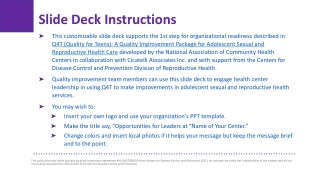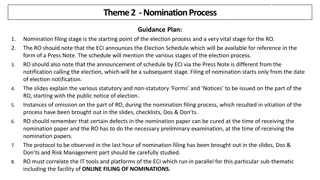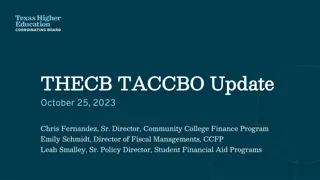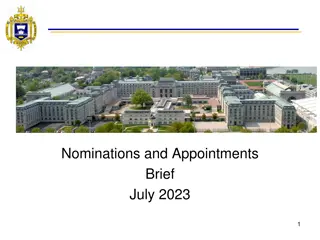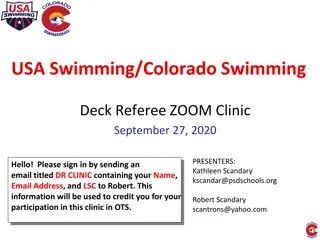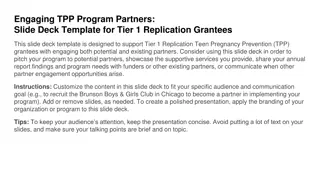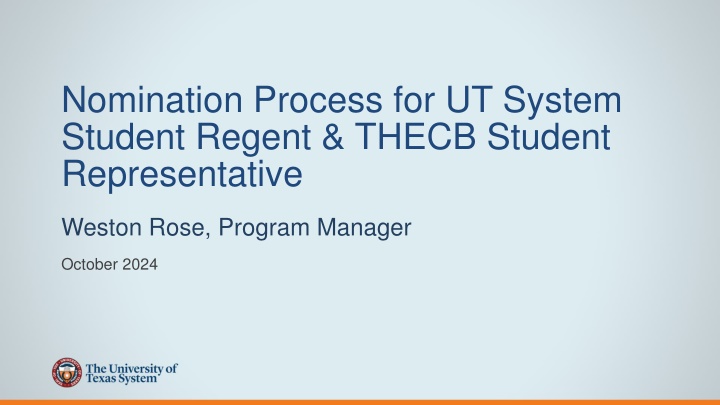
Nomination Process for UT System Student Regent & THECB Student Representative
Explore the nomination process for the UT System Student Regent and THECB Student Representative positions, including eligibility, timeline, and key aspects of the Texas Education Code. Discover how to develop a strong application for these student leadership roles.
Uploaded on | 1 Views
Download Presentation

Please find below an Image/Link to download the presentation.
The content on the website is provided AS IS for your information and personal use only. It may not be sold, licensed, or shared on other websites without obtaining consent from the author. If you encounter any issues during the download, it is possible that the publisher has removed the file from their server.
You are allowed to download the files provided on this website for personal or commercial use, subject to the condition that they are used lawfully. All files are the property of their respective owners.
The content on the website is provided AS IS for your information and personal use only. It may not be sold, licensed, or shared on other websites without obtaining consent from the author.
E N D
Presentation Transcript
Nomination Process for UT System Student Regent & THECB Student Representative Weston Rose, Program Manager October 2024
Agenda for Webinar Learning Objectives Overview of the UT System Board of Regents & Student Regent Position Overview of the Texas Higher Education Coordinating Board & Student Representative Position Note on the Non-Voting Student Representative on Certain Advisory Committees Timeline Nomination Process Eligibility Tips for Strengthening Applications Knowledge Check 2
Learning Objectives By the end of this slide deck, students will be able to: Describe the UT System Board of Regents, the THECB, and the student positions appointed to both. Explain the nomination process for UT System Student Regent and THECB Student Representative including timeline, eligibility requirements, and key aspects of Texas Education Code, Sections 51.355 and 61.0225. Develop a strong application for the UT System Student Regent and/or THECB Representative position(s). 3
The UT System Board of Regents The Board of Regents is the governing body for The University of Texas System and is comprised of nine members who are appointed by the Governor and confirmed by the Senate. The Board names officers (i.e., Chairman and two Vice Chairmen) and is organized into committees (i.e., Academic Affairs, Finance and Planning, etc.) each led by a Chairman. The Board holds regular meetings in February, May, August, and November. Combined committee meetings and Board meetings take place over a two-day period in February, May, August, and November, with committee meetings usually held on Day 1 and the general Board meeting on Day 2. The Board also holds special called meetings, as necessary. Open meetings are usually webcast live. 4
What is a Student Regent? Definition: A Governor-appointed student position on a university system s Board of Regents. However, a student regent is not a member of the board of regents of the system for which the student regent is appointed. Purpose: The purpose of the student regent is to represent all students within a university system. Term: The student regent is appointed by the Governor and serves a one-year term from June 1 to May 31 of the following year. Rights: The UT System Student Regent has the same rights as regularly appointed board members, except the right to vote or be counted towards a quorum for official board business. Compensation: The position serves without compensation, but the student will be reimbursed for expenses incurred during official Board business. 5
What Qualities are Needed in a Student Regent? Ability to maintain a systemwide perspective Demonstrated leadership ability Professionalism Excellent written and verbal communication skills Familiarity with and fluency in higher education topics and trends Attendance at Board meetings Ability to review 300+ pages of reading material (6-10 hours of review) for each regularly scheduled Board Meeting (6 times a year). There are also Special Called Board Meetings. Reading materials are sent 10 day prior to the Board Meeting. 6
The Texas Higher Education Coordinating Board The Texas Higher Education Coordinating Board (THECB) is a state agency that oversees public post- secondary education. The Board is composed of 10 members who are appointed by the Governor. The Board meets quarterly in Austin, and all meetings are broadcast live on the internet. 7
What is the THECB Student Representative? Definition: A Governor-appointed student position on the Texas Higher Education Coordinating Board. Purpose: The purpose of the student representative is to represent all students across public institutions of higher education in Texas. Term: The THECB Student Representative is appointed by the Governor and serves a one-year term from June 1 to May 31 of the following year. Rights: The THECB Student Representative has the same rights as regularly appointed board members, except the right to vote or be counted towards a quorum for official board business. Compensation: The student representative serves without compensation, but the student will be reimbursed by the Coordinating Board for expenses incurred during official board business. 8
What Qualities are Needed in a THECB Student Representative? Ability to maintain a statewide perspective Demonstrated leadership ability Professionalism Excellent written and verbal communication skills Familiarity with and fluency in higher education topics and trends Attendance at Board meetings Ability to review reading materials prior to Board Meetings 9
Non-Voting Student Representative on Certain Advisory Committees UT System does not manage the nomination for Non-Voting Student Representative on Certain Advisory Committees. Texas Education Code, Section 61.071, requires the THECB to appoint non-voting student representatives to certain advisory committees. Students seeking nomination to an Advisory Committee may serve on one of four THECB advisory committees for a two-year term beginning June 1 and ending May 31. The advisory committees are: ApplyTexas, Financial Aid, Learning Technology, and Texas Transfer. The student perspective is very valuable to these committees, and student participation is highly encouraged. Students must be nominated through the president s office of each institution. 10
Timeline for Student Regent & THECB Rep. Nominations Deadline Description September/October UT System distributes a Call for Nominations for UT System Student Regent & THECB Student Representative to UT academic and health institutions. November 1 No later than November 1 of each year, the student government of each general academic teaching institution and medical and dental unit in a university system shall solicit applicants for appointment to the next regular term of the position of student regent and THECB Student Representative. December 6 The president of each institution submits no more than five applicants for each position to Weston Rose, Program Manager in the Office of Academic Affairs at UT System. All other applications must be retained in the president's office until the Governor names the appointments. February 1 No later than February 1, applicants are forwarded to the Governor for consideration. June 1 Around June 1, the Governor appoints the UT System Student Regent. 11
Nomination Processes Per Texas Education Code, Sections 51.355 and 61.0225, the Student Government Association of academic and health institutions shall solicit applicants for these positions no later than November 1 and from among the applications received by the student government, the student government shall select five applicants as the student government's recommendations. Please note that while Texas Education Code, Sections 51.355 and 61.0225 refer to the university system receiving applications no later than January 1, UT System has moved this deadline to December 6 (as we have done for decade or more). The rationale is to allow students and university staff to submit before the end of the semester and to provide ample time to review applications at the System level. The president of each institution submits no more than five applicants for each position by December 6. A selection committee consisting of representatives from the Offices of Academic Affairs, Health Affairs, and Governmental Relations reviews applications and makes recommendations to the Chancellor. The Chancellor reviews the finalists and selects two or more applicants as the university system s recommendations to the Governor no later than February 1. Per statute, [t]he governor may request to review all applications [ ] and may request an applicant to submit additional information to the governor [and] [t]he governor is not required to appoint an applicant recommended by the chancellor. 12
Eligibility Must remain enrolled as an undergraduate or graduate students at the institution throughout the person s term. If the applicant is an undergraduate who is graduating in May, the applicant must be accepted as a graduate student at the same institution for Fall of the same year. The UT System Student Regent form has been revised this year to explicitly request this information from applicants. Must be in good standing, as certified by the registrar s office. There is a space on the form for the Registrar to certify good standing. Commit to fulfill all minimum time commitments for a UT System Student Regent during the term of service. Meeting Attendance. Attend regularly scheduled meetings six times a year, as well as special called meetings. Meeting Preparation. Required reading per meeting involves 300+ pages of materials (6- 10 hours of review). Reading materials are provided 10 days prior to the scheduled meeting. Regent Orientation. One full day to brief new Regents on the responsibilities and value added by offices of UT System Administration. Training. An estimate four hours for training/reading on subjects like conflict of interest, ethics, open meetings, and open records requirements. Review of Regents Rules.The Regents Rules and Regulations are the policies established by the Board of Regents. Eight hours is estimated for a new Regent to become familiar with the content of those Rules. Maintain a statewide perspective on higher education (as opposed to representing any single college or university). A 2.5 grade point average or higher on a 4.0 scale must be maintained to continue eligibility. This GPA threshold is considerably lower than the GPA requirements of graduate students. Per statute, [t]he student government of the general academic teaching institution or medical and dental unit at which a current student regent was enrolled at the time of the student regent's appointment may not solicit applicants for the position of student regent for the next regular term of the position. 13
Tips for Strengthening Applications Writing Your Application: Research the UT System Student Regent and THECB Student Representative positions. Consider reviewing past UT System Board of Regents Meetings to prepare. Research trends and current topics in higher education, especially in Texas. Chronicle of Higher Education, newspapers (national, state, regional), etc. Keep your audience in mind while writing. When writing the sections that request students to list leadership qualifications or identify issues they would address should they be appointed, use the Goldilocks Principle. Stay within the word limit, but also write more than a single word, phrase, single sentence. Demonstrate your familiarity with higher education topics, trends, and terminology. Be specific about issues and cite data but avoid mentioning specific laws in your written section. When writing about issues to address, students should maintain a systemwide perspective. Often, students will only focus on their institution. Ensure your tone is appropriately formal and professional and use standard grammar and mechanics. Avoid incomplete sentences, misspellings, contractions, and slang. Editing Your Application: Use a robust system of checks to ensure your application: meets the eligibility requirements, includes all the required documents, and has been carefully proofread (i.e., visit the Writing Center, ask a mentor to review) and that you have considered and implemented feedback. 14
Written Example 1 Higher Order Concerns: Responses lack specificity or detail. The student states, more action needs to be done and that we should find better ways but these vague phrases do not demonstrate data-driven, concrete steps that should be taken. Responses do not cite any data and do not demonstrate familiarity with topics, trends, or terminology used in higher education. Lower Order Concerns: Response #1 is an incomplete sentence, and misspellings are found throughout other responses. Informal tone (i.e., amongst ). 15
Written Example 2 Higher Order Concerns: Response include specificity (e.g., Hazelwood Program ), detail (e.g., GME funding), and data (e.g., income about 1/5 ). Overall, these responses leave the impression that the student appears informed on topics in higher education, maintains a systemwide perspective, and inspires confidence that the student could succeed in this role, if selected. Lower Order Concerns While there are a few mechanical imperfections as well as abbreviated terms (e.g., undergrad ), overwhelmingly this nominee s responses demonstrate good use of standard grammar and mechanics and convey a formal, professional tone. 16
Packaging Your Application Please package all documents in a single PDF to ensure all materials are received, if possible. Please also do not lock the document because it may cause us issues at the System level. Please do not bookmark sections. Please do not send the instructional sheet we provide. These instructions are meant to aid the student applicant. We don t need it included in the final application 17
Question 1 The UT System Student Regent is a member of the UT System Board of Regents. True False 22
Question 1 The UT System Student Regent is a member of the UT System Board of Regents. True False Answer: No, the Student Regent is not a member of the Board of Regents according to Texas Education Code, Section 51.355(e). Rather, the Student Regent is a Governor-appointed student position on the Board. A student regent has the same powers and duties as the members of the board of regents of the system, including the right to attend and participate in meetings of the board of regents. However, the Student Regent may not vote on any matter before the board or make or second any motion before the board, and the Student Regent is not counted in determining whether a quorum exists for a meeting of the board or the outcome of any vote of the board. 23
Question 2 The UT System manages the Non-Voting Student Representative of Certain Advisory Committees. True False 24
Question 2 The UT System manages the Non-Voting Student Representative of Certain Advisory Committees. True False Answer: No, UT System only manages the nomination process for the UT System Student Regent and Texas Higher Education Coordinating Board (THECB) Student Representative. UT academic and health institutions submit nominations to UT System in early December each year. If you are interested in the Non-Voting Student Representative of Certain Advisory Committees, you should contact the President s Office at your institution. Learn more about the nomination process at the link below: https://www.highered.texas.gov/about/non-voting-student-rep-on-certain-advisory-committees/ 25
Question 3 I am an undergraduate at a UT health institution graduating in May 2025. The current Student Regent represents a UT academic institution. I have applied and been accepted to a graduate program at the same institution. Am I eligible to apply for either position? True False 26
Question 3 I am an undergraduate at a UT health institution graduating in May 2025 with a GPA of 3.5. The current Student Regent represents a UT academic institution. I have applied and been accepted to a graduate program in Fall 2025 at the same institution I currently attend. Am I eligible to apply to the UT System Student Regent position? True False Answer: Yes, this student is eligible to apply to the Student Regent position because the student (1) will remain continuously enrolled at the same institution, (2) meets the GPA requirement in statute, and (3) represents a UT institution at which the current Student Representative does not represent. 27
Question 4 I am an undergraduate at Stephen F. Austin State University graduating in May 2025 with a GPA of 4.0. I have been accepted to a graduate program at UT Austin in Fall 2025. Am I eligible to apply for the Student Regent position? True False 28
Question 4 I am an undergraduate at Stephen F. Austin State University graduating in May 2025 with a GPA of 4.0. I have been accepted to a graduate program at UT Austin in Fall 2025. Am I eligible to apply for the Student Regent position? True False Answer: No, this student is ineligible to for the Student Regent position because the student will not remain continuously enrolled at the same institution (in this case, SFA). 29
Question 5 When completing the UT System Student Regent form, which elements should I keep in mind in order to write a strong application? 30
Question 5 When completing the UT System Student Regent form, which elements should I keep in mind in order to write a strong application? Answer: In terms or Higher Order Concerns, remember to keep your audience in mind and conduct research into the position, the Board of Regents and/or Coordinating Board, and higher education trends/topics. Remember the Goldilocks Principle don t write a mere word or sentence but stay within the bounds of the text field and/or word maximum. When writing, be specific and include data but avoid citing specific laws. Maintain a systemwide/statewide perspective. In terms of Lower Order Concerns, maintain a formal tone and use standard grammar and mechanics. 31

